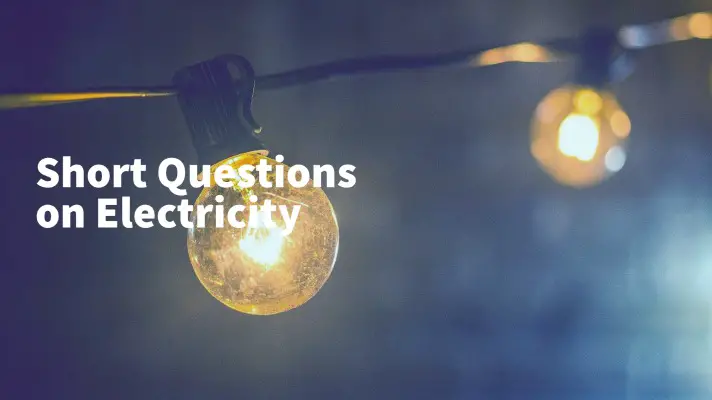Recently as many examinations are happening in online mode and typing the answers to short questions is very easy, maximum questions are of short questions and multiple-choice questions. In this article, I will discuss some Short Questions on Electricity. This will surely remove your doubts and will give you a clear concept of Electricity.
At the end of the article, there is a pdf downloadable button. If you want to download this article, go to the end section and click on that button.
Without wasting your times, let’s start the Short Questions.
For multiple-choice questions on Electricity, click on the following link:
Short questions on Electricity

What is the basic principle of electricity?
Electricity is the flow of free electrons along the conductors from one object to another object. We feel current when electron flows.
What are the components of an electrical system?
The basic components of an electrical system are:
Transformer
Battery
Fuse
Switches
Relays
Motor
Circuit breakers
What is a circuit and its types?
A circuit is a path around which electricity flows. The source of electricity is the battery.
From the battery, you will get the electric energy and then you can convert this energy into mechanical energy or other forms of energy as per your requirement.
The path may be closed or may be open. This is the reason, circuits are of two types:
Closed circuit and Open circuit
When the path is a closed one, the circuit is a closed circuit. In the closed circuit, electricity will give you output as the path is complete in this case.
When the path is an opened one, the circuit is an open circuit. In the open circuit, you will not get any output from the electricity. As the path is not complete in this case, electricity does not reach the final object.
Series circuit and parallel circuit
When the different types of resistances are connected in series the circuit becomes a series circuit and when the different types of resistances are connected in parallel, the circuit becomes a parallel circuit.
If the different types of resistances are r1, r2 and r3; the equivalent resistance in series circuit is R = r1+r2+r3 and in parallel circuit 1/R = 1/r1+ 1/r2 +1/r3
In a series circuit, if a problem exists in one connection and the current can’t pass through, the other two connections will also be hampered.
In parallel circuit, it is not so.
What are the two types of current?
There are two types of currents: Alternating current and direct current. From the battery charger, you will get the direct current. From the transformer, you will get alternating current. A rectifier is there in the battery charger. It converts the alternating current into a direct one.
In case of an alternating current, polarity changes. This means the direction of movement of electrons changes.
What is a circuit breaker?
A circuit breaker acts as a security/safeguard of the electric circuit. High voltage current or short circuit current may become the reason for your injuries also may damage your electrical components.
Therefore, circuit breaker does not allow the unsafe current to flow further.
What are the different types of circuit breakers?
There are:
Type B Circuit Breaker
Type C Circuit Breaker
Type D Circuit Breaker
Type B circuit breakers trip the current when it becomes 3 to 5 times higher than that of rated current. For example, if the rated current is 15A, it will trip at 45 to 75 A.
Similarly type C breakers trip the current when it becomes 5 to 10 times higher than that of rated current.
And type D breakers trip the current when it becomes 10 to 20 times higher than that of rated current.
What is electrical wiring?
Electric wiring is the connecting path or cable between any two electric components such as switches, fuse, etc.
These cables are of copper or aluminium.
What are the different sizes of wires available in the market?
Low size cables: 1 mm, 1.5 mm, 2.5 mm
large size cables: 4 mm, 6 mm, 10 mm,
Largest size cable: 12.7mm
What are the colour codes of the electric wires?
Red – live wires or phase wire
Black/ white – nutral wire
Green – earthing wire
Blue/yellow – hot wires
What are the different types of voltages?
As per ANSI C84.1-2016:
Low voltage – less than or equal to 1000 volts
Medium voltage – 1000v < V < 100 kv
High voltage – 100 kv < V < 230 kv or equal to 230 kv
Extra high voltage – 230 kv < V < 1000 kv
Ultra high voltage – 1000 kv or greater than 1000 kv.
Conclusion
I hope that you like the short questions which I have displayed here. I am sure that the article “Short Questions on Electricity” will be helpful to you. If you want me to write some short questions on some other topics, please let me know by writing in the comment box. Best wishes!


